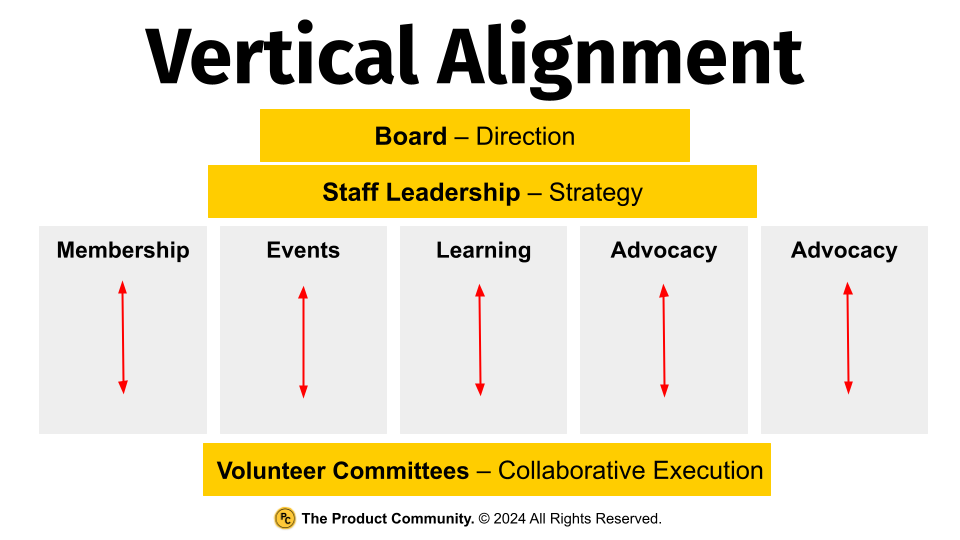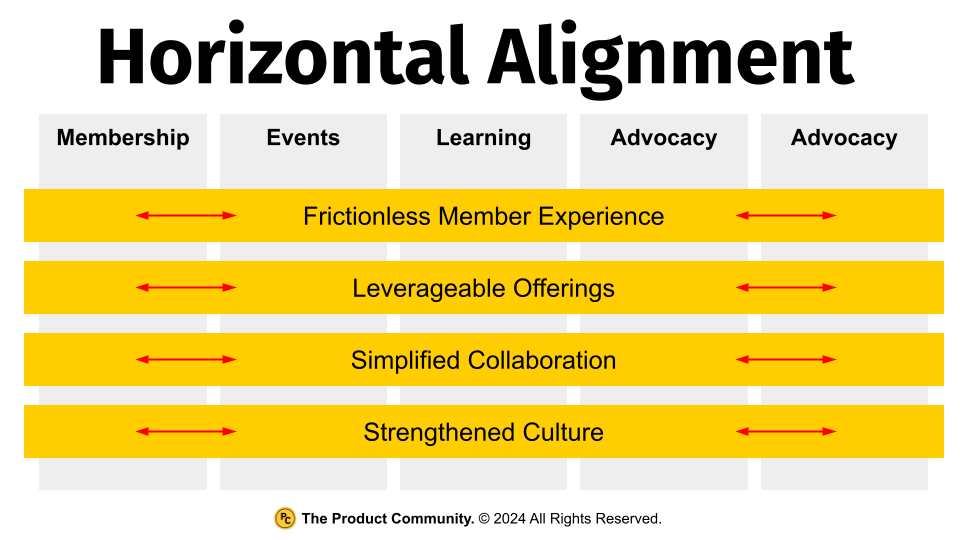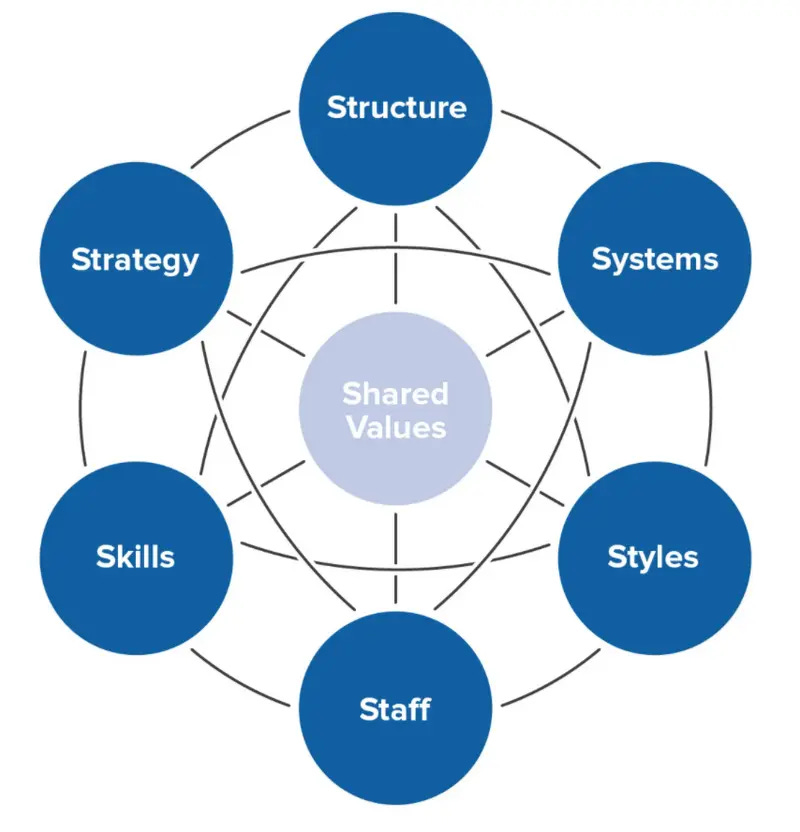Simple Collaboration on a Massive Scale
An Alignment Tool to Maximize Collaboration on Shared Outcomes
Summary
Alignment is the harmonization of goals, strategies, activities, and values across all levels of an organization from leadership to members. It ensures that everyone works cohesively towards shared objectives. It typically means there is a healthy orientation toward collaboration.
Yes, alignment is more than simple collaboration. At its most basic, it’s breaking down barriers, achieving shared buy-in, and working for shared outcomes. At its most innovative, it’s a lever for innovative practice and the fuel for making impact and reaching ambitious outcomes.
This article offers an assessment tool to guide you on your alignment journey. In exploring both vertical and horizontal alignment, I stress intentionality and the potential multiplier effect of investing and executing on true innovation.
The product community is a product development learning community designed specifically for associations.
A Overview of Alignment
“When you begin with a sense of deep alignment and have a nuanced understanding of, and empathy for, the other people involved, you will not only avoid arguments but also you’ll be able to see opportunities previously invisible. When you reduce unnecessary interpersonal friction, you unlock the true potential of teams.”
Alexandra Jamieson and Bob Gower
Alignment is an indicator of how in-tune we are; it refers to the process of cohering an organization’s structure, resources, and strategies with its overall mission, vision, and goals. This ensures that all parts of an org work together effectively toward a common purpose and that individual and departmental objectives support the broader organizational aims. Alignment is important for several reasons:
Enhanced Efficiency – Alignment fosters effective resource use as people concentrate on activities that support the overall strategy. This reduces duplication and streamlines processes, leading to better performance.
Clear Direction – Organizational alignment provides a clear direction for staff at all levels. When everyone understands how their roles and responsibilities contribute to the larger goals, it enhances focus and motivation.
Improved Communication – Alignment fosters better communication. When goals and strategies are clearly defined and understood, it reduces misunderstandings and ensures that everyone is on the same page.
Increased Engagement – Staff who see a direct connection between their work and the organization’s goals are more likely to be engaged and motivated. This helps foster a sense of purpose and commitment.
Better Decision-Making – With clear alignment, decision-making becomes more straightforward. Decisions can be made with the organization's strategic objectives in mind, leading to more consistent and effective outcomes.
Adaptability and Flexibility – Orgs that are well-aligned are better equipped to adapt to changes in the market. A strong alignment between strategy and execution allows for more agile responses to external challenges and opportunities.
Achievement of Strategic Goals – Alignment helps ensure that strategic goals are achieved. When all elements of the organization are aligned with its strategic vision, it increases the likelihood of successfully reaching those goals.
Alignment is important because it ensures that everyone works towards common objectives. This is good, but isn’t enough. Most alignment is vertical (management downward to staff or staff upward to management).
Overly strict vertical alignment can foster managerialism, internal competition, siloed operations, and tactical outcomes. The real impact of alignment is combining vertical alignment with the robust, collaborative nature of horizontal alignment.
Let’s look at a tool to anchor your association in the world of alignment.
The Alignment Assessment – A Tool for Achieving Big Goals
“When in doubt, check if your actions are aligned with your purpose.”
Azim Jamal & Brian Tracy
I developed an alignment assessment to help associations understand the effectiveness of their alignment efforts.
This assessment was designed to help associations align their value creation efforts, but can be used in a number of different ways (to implement strategy or to conduct annual planning). I use the phrases value creation and product development synonymously here (think of them as the value you create or deliver for your members).
The assessment has five sections: collaboration and roles, planning, budget and resource allocation, communication, and performance. Feel free to copy, use, or adapt this survey as you see fit. Depending on the outcomes of the assessment, your association will be gauged on of four levels:
Innovative and healthy
Proactive and engaged
Reactive and fragmented
Siloed and untrusting
The power of alignment is not just in hitting goals and achieving initiatives. It is how we hit our targets and achieve outcomes. A highly aligned organization is well-tuned, ordered, and effective. It is also loose, trusting, open, and fun.
Horizontal Alignment – Collaboration Across Boundaries
“Building a visionary company requires one percent vision and 99% alignment.”
Jim Collins and Jerry Porra
Horizontal alignment is collaboration across departments, chapters, or external partners, to achieve common goals and enhance overall effectiveness. This type of alignment emphasizes breaking down silos, fostering cross-functional cooperation, and leveraging diverse expertise to address complex challenges or opportunities.
Here are some examples of horizontal alignment:
Cross-Functional Teams – The American Marketing Association (AMA) forms cross-functional teams comprising members from different chapters and specialties (e.g., digital marketing, market research, brand management) to develop comprehensive best practice guides. This ensures that the final product benefits from diverse perspectives and is applicable across various marketing disciplines.
Inter-Chapter Collaboration – The Association of Certified Fraud Examiners (ACFE) encourages horizontal alignment through its "Chapter Exchange Program." This initiative allows members from different regional chapters to collaborate on fraud prevention, sharing local insights to create more globally applicable anti-fraud strategies.
Shared Resource Platforms – The American Library Association (ALA) has implemented a shared digital platform where different divisions (e.g., public libraries, academic libraries, school libraries) can collaborate on content creation, professional development resources, and advocacy initiatives. This helps maximize resource utilization and promotes knowledge sharing across library types.
Interdisciplinary Task Forces – The American Psychological Association (APA) forms interdisciplinary task forces that include psychologists, educators, and policymakers to address complex societal issues like childhood obesity or mental health in schools. This horizontal alignment ensures a holistic approach to problem-solving.
Knowledge Exchange Programs – The International Association of Fire Chiefs (IAFC) implemented a knowledge exchange program where fire departments from different regions or countries share best practices, innovative techniques, and lessons learned. This helps improve firefighting and emergency response capabilities across boundaries.
Collaborative Advocacy Efforts – Multiple healthcare associations, such as the American Medical Association, American Nurses Association, and American Hospital Association, align horizontally to advocate for comprehensive healthcare reform. By presenting a united front, they increase their influence in policy discussions.
Shared Technology Initiatives – Various state bar associations collaborate horizontally to develop and implement a common online continuing legal education (CLE) platform. This alignment reduces individual development costs and creates a more standardized, user-friendly experience for lawyers across states.
These examples of horizontal alignment demonstrate how associations can break down internal and external boundaries to foster collaboration, share resources, and achieve common goals. By combining vertical alignment (towards organizational vision and goals) with strong horizontal alignment, associations can create a more dynamic, responsive, and impactful organization for members and stakeholders.
Massive Returns
“Leaps of greatness require the combined problem-solving ability of people who trust each other.”
Simon Sinek
With proper investment, org-wide buy-in, and a commitment to execute together toward the future, alignment can indeed result in massive returns. Baseline alignment is simple, professional coordination. It ensures we work together toward shared goals in a way that serves organizational outcomes and feeds a healthy culture of collaboration. Typically, this is the type of alignment we’re familiar with: it is important as it motivates us to execute on the association’s strategic initiatives.
It’s important, but not enough.
Great alignment – the kind that hinges on open collaboration and shared values – results in the massive returns we all desire: mutually beneficial outcomes, healthy culture, a humming pipeline of good ideas, and diversified revenue.
I lead the product community; we are a learning community because we believe great relationships help us create the value our members want. Remember, product-led growth fuels connection. Join the product community and flip your destiny.
About the Author
James Young is founder and chief learning officer of the product community®. Jim is an engaging trainer and leading thinker in the worlds of associations, learning communities, and product development. Prior to starting the product community®, Jim served as Chief Learning Officer at both the American College of Chest Physicians and the Society of College and University Planning. Please contact me for a conversation: james@productcommunity.us






